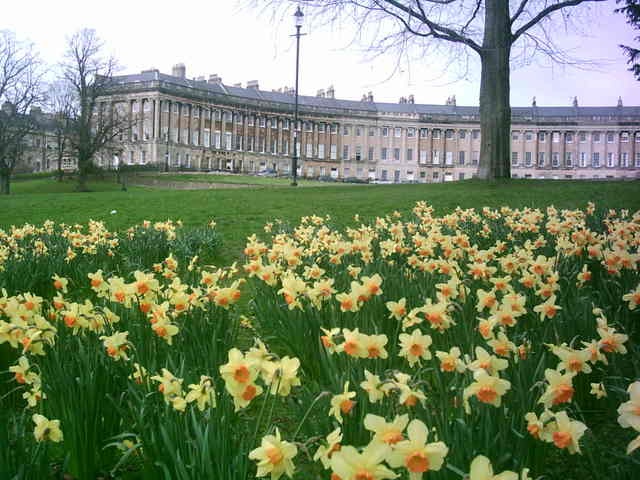
The Royal Crescent in bloom ! - Image by PicturesOfEngland.com member victorian67 (view gallery)
Daffodils are a beautiful yellow flower that comes into bloom in early springtime in England, painting dashes of yellow against our verges and hedgerows, and decorating our village greens, gardens and public parks. However, it is at some of England's finest Country Houses and Stately Homes where the most elaborate displays can be seen, so why not treat yourself and your family to a day out at one of these stunning locations, where the incredible daffodil displays will just be part of the wonderful experience.
This article covers places to see Daffodils in England's South West, including Devon and Cornwall, Somerset and Wiltshire. We will cover other regions of England in future articles and lists. If you know of any great places to see daffodils, please let us know in the forums or comments section of the article, and don't forget to get out there and take some photos of daffodils to add to the Pictures of England website for all to enjoy - Thank you.
PLEASE CHECK before you set off on your journey that the daffodils are in full bloom at your destination, as it can be very much dependant on the weather if they show early or late, so please do check!
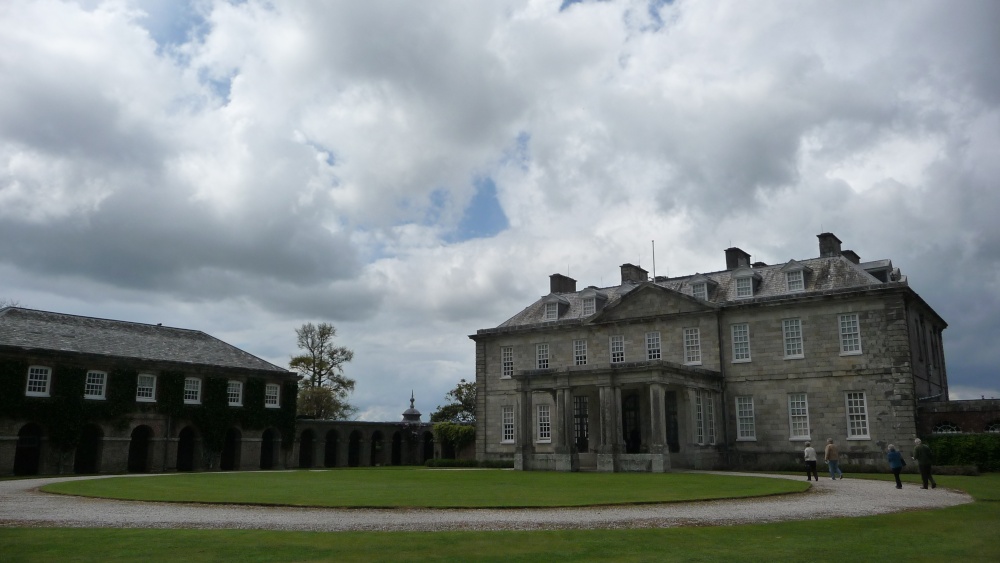
Antony House - Image by PicturesOfEngland.com member Ken Ince (view gallery)
This elegant rectangular house was built for Sir William Carew between 1711 and 1721. The building, which is to a simple design is of silver-grey stone with foliage covered brick wings. This has been the home of the great Cornish Carew family for over 600 years, with a previous house having stood on the same spot.
The entrance facade shows dormer windows set into the roof, nine windows to the first storey, and eight below. The front porch with its graceful glass panelled entrance door is an addition of 1839. Given it's exterior appearance of light and grace, the interior of Antony House comes as a surprise, for the rooms are somewhat smaller than expected. None-the-less, the rich Dutch oak panelling of the period is a joy to behold.
In the Library, visitors to the house can see a copy of Richard Carew's Survey of Cornwall, published in 1602. Other rooms contain fine furniture made for the house, excellent family portraits, sporting paintings, and porcelain. There is also a superb collection of Soho tapestries in the tapestry room.
The ground floor is arranged with rooms leading off a central hall from which a fine staircase rises in two broad flights. At first floor level visitors can see a series of splendid bedrooms, lavishly furnished in 18th century style.
Antony House is surrounded by landscaped grounds and garden which were laid out by Henry Repton, these run down to the picturesque River Lynher, giving the opportunity for quiet riverside strolls. In the grounds there is much stone carving and a Burmese temple bell brought back by Sir Reginald Pole-Carew from India and Burma. The garden features a formal courtyard, terraces abundant with flowers, an ornamental Japanese pond and a Knot garden. There are lovely woodland walks and a huge collection of day lilies.
A visit to this beautiful house offers enjoyment for all the family. There is a restaurant for refreshment, glorious picnic spots, a shop for souvenirs, and at certain times of the year the house hosts special events including open-air concerts.
ID#10224
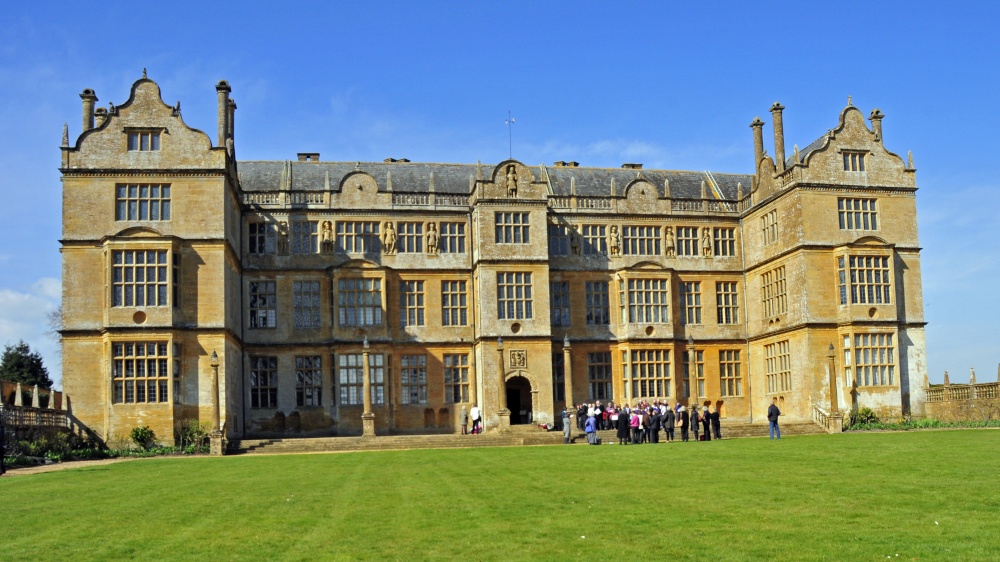
Barrington Court, Somerset - Image by PicturesOfEngland.com member Paul V. A. Johnson (view gallery)
Barrington Court is an attractive 16th-century house built in the engaging "E" shaped style of the period in mellow Ham Hill stone. At the time of its inception this house was one of the grandest in Somerset.
Later, it was left to fall into disrepair, and was notably restored by the Lyle family in the early part of the 20th-century, when its gardens were taken into hand by Gertrude Jekyll.
The Tudor Manor House is let to Stuart Interiors as a splendid backdrop for the sale of antique furnishings. Thus visitors to the house (owned by the National Trust) get a two-fold experience. They are able to explore lavish interiors whilst buying antique pieces, and afterwards visit the garden which Gertrude Jekyll laid out in a series of room-like settings. These include a White garden, Rose garden, Lily garden and Iris garden. There is a working Kitchen garden with apple, pear and plum trees growing against high stone walls.
Visitors are also able to see the Stable Block of the 17th-century.
On a note of historic interest; When Barrington Court came into the possession of the National Trust in 1907, it was the first country property of a notable size to be purchased by them, and it was not until it was leased to Colonel Lyle in 1920, that the building was finally restored.
The house is remarkable for its gracious appearance, it crowns the wonderful Somerset horizon with deep gables, splendid chimneystacks and intricate finials.
Barrington Court is open to the public from April to September - it is well worth a visit.
ID#9484
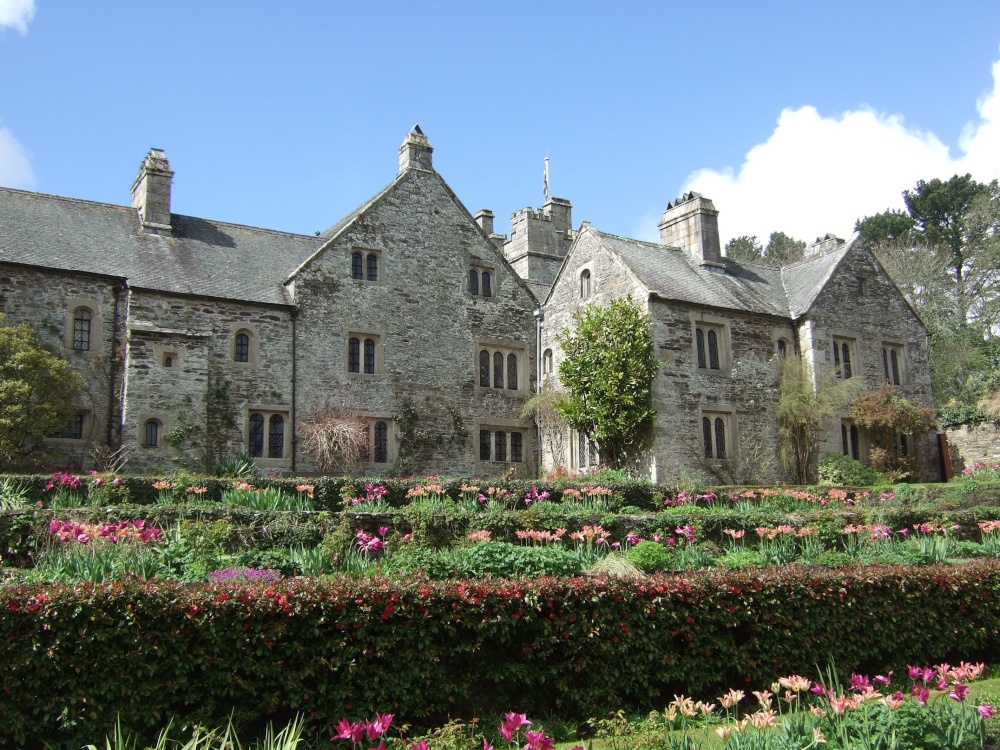
Cotehele House in Spring - Image by PicturesOfEngland.com member Phil Jobson (view gallery)
Tudor house with superb collections of textiles, armour and furniture, set in extensive grounds.
ID#10131

Agatha's House. - Image by PicturesOfEngland.com member Michael Cassidy (view gallery)
The house called Greenway sitting serenely in attractive countryside has been an important Devon home for centuries, during which time there has been a long line of illustrious inhabitants since the first house was built here late in the 15th-century. It was then the home of the Gilbert family who lived in it for just over one hundred years. The Roopes bought it in 1700, and remained for almost a hundred years, and from then on the fortunes of the house fluctuated as it passed through several owners. But oddly, the garden was always greatly loved by most of them, and it is the contribution of centuries of enthusiastic gardeners that has made Greenway the stunning place it is today.
The first recording of a house here is of Greenway Court, a delightful Tudor mansion near the crossing point of the River Dart to Dittisham. This was built for Otho and Katherine Gilbert, a noted couple who raised three children here. Two of their children achieved fame, and the favour of Queen Elizabeth I. Sir Humphrey took New Zealand for Elizabeth, after-which he remained a favourite at her Court, whilst his brother, Sir John became Lord Lieutenant of the County.
Quite probably Roope Harris Roope built Greenway House next to what must have been the court. He was a merchant adventurer of many talents. Excavations of more recent times revealed parts of the foundations of the older property. Roope however, is mainly recalled for his sea-faring prowess, he developed trade with what was then the new world. One of his relations produced a species of the Camellia, probably from plants and seeds he brought back from sunnier climates.
By the time it was sold again in 1791 to Edward Elton a merchant adventurer, Greenway must have been a substantial property for it fetched £9,000, a significant sum in those days. This family enhanced the property with the addition of two wings, re-routed the entrance, added a lodge, and landscaped the grounds after the style of Humphrey Repton. These gardens remain as blissfully attractive today as they must have appeared all those decades ago. Vivid Camellia's blossom here amongst original garden buildings, and there are lawns bordered with beech trees, a study of autumnal perfection as their leaves change from green to gold.
Future owners concentrated heavily upon beautifying the already lovely landscape, as is evidenced in notes retained for posterity. The addition of glasshouses in the 19th-century meant that exotic plants could be nurtured, and soon visitors to the house could see Acacia, Clianthus and Myrtles.
In 1892 Greenway sold for £44,000 to Thomas Bolitho, a Cornishman from Trewidden who happened to be a keen plantsman. About this time the garden at Greenway began to be mentioned in the Gardeners Chronicle, most notably in 1899 and 1901. After Thomas died in 1919, his daughter Mary and her husband Charles Williams took over. They are responsible for the vast array of daffodils and other spring flowers, as well as for huge banks of Rhododendrons and a fresh influx of Camellia and Magnolia.
A local business man bought the estate from the Williams's in 1937, for whatever reason he chose to split it up and although no one exactly knows when Agatha Christie first set eye's on Greenway, what is known is that she immediately fell in love with it, buying the house together with 35 acres of grounds for £6,000. Agatha Christie is known throughout the world as "The Queen of Crime" she remains the world's best selling author other than William Shakespeare whose sterling reputation made Stratford-upon-Avon renowned throughout the world.
Fortunately both Agatha and her husband Max Mallowan were keen gardeners, Greenway was their holiday home and here together they carried on with the gardening traditions first established by Roope Harris Roope so very long ago. Max Mallowan was knighted for his services to archaeology and later Agatha Christie was made a Dame of the British Empire. Agatha Christie gifted Greenway to her daughter Rosalind in 1959. Dame Agatha died 17 years later in 1976 at the age of 85. Her daughter died as recently as 2004, strangely enough also at the age of 85. Four years before her death Rosalind and her family agreed to give this historic place together with Lower Greenway Farm to the National Trust.
The gardens of Greenway occupy an outstanding position fronting the beautiful River Dart, they are a riot of exceptional colour and beauty all the year round. They are perfectly arranged and yet in certain areas resemble a mysterious wilderness, giving the garden a vulnerability often lacking in more seasoned formal settings. Here amongst nature guided by the hand of man, you can enjoy a beautiful walled garden, a colourful Hydrangea Walk, Woodland walk, Victorian Fernery, the Top Golf Lawn and the Top garden. Greenways is a superb combination of charm and beauty which is well worth seeing. It is a garden that grips your attention with little to detract except for the fascinating views of river traffic plying the waters of the River Dart, and the wildlife thronging around it.
Access can be gained by a number of ways including ferry! In compliance with the request of local people, the gardens are open for only 37 weeks of the year and visitor numbers are limited to 40,000.
There is little doubt that these recently opened gardens will quickly become an international tourist attraction, whilst on the home-front they are a must for any keen gardeners calendar.
ID#10550
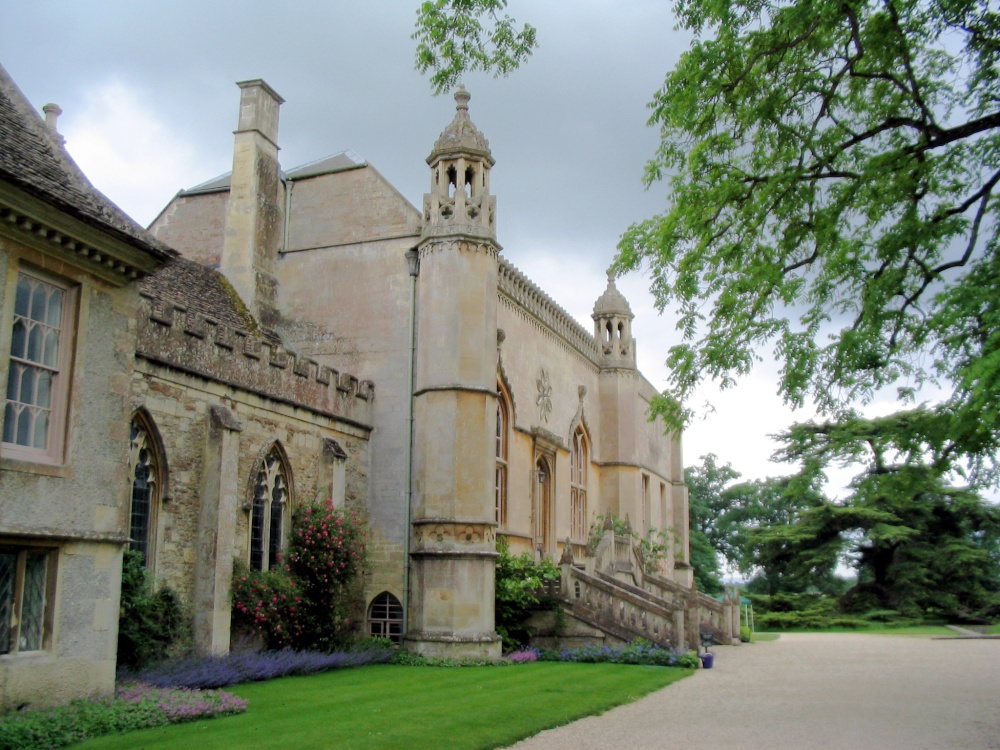
Lacock Abbey - June, 2003 - Image by PicturesOfEngland.com member Judith Hays (view gallery)
Lacock is one of the most beautiful villages in England, with houses dating from the 15th-century to the 18th-century. At the heart of the village lies the magnificent abbey founded by Ella, Countess of Salisbury in the year 1232. The abbey building is a confection of many styles and features a stunning octagonal tower, tall chimney pots and decorative mullioned windows. It remained an abbey until the reign of Henry VIII when the Dissolution of the Monasteries was caused by the Henry's wish to divorce Queen Catherine.
At the time of the Dissolution, the abbey was sold to William Sharington who made it his home. He had travelled widely on the continent and had a particular love for Italy, thus he introduced the Italian style of architecture to the alterations to be made to Lacock Abbey. When he died in 1553 having no issue, the house passed to his niece Mrs John Talbot. Between the 18th and 19th-centuries the Abbey underwent a series of alterations and the stunning Gothic revival style is a legacy from the 18th-century when alterations were made by the architect Sanderson Miller.
The Abbey remained in the ownership of the Talbot's for over 400 years. During this time the family's most famous member was William Henry Fox Talbot, who in 1835 pioneered the development of the world's first photographic negative. His subject was the oriel window in the south gallery, and today a print of the negative hangs close to the window making the house a Mecca for photographic enthusiasts. The Fox Talbot Museum of photographic memorabilia is located in a converted barn outside the abbey gates.
Lacock Abbey offers many experiences and is well worth a visit. The cloister and the chapter house are strongly atmospheric of the austere lives of the nuns who surrounded Ella when she was Abbess. Nun's followed the religious way of life at Lacock Abbey for over three centuries and this part of the abbey is in stark contrast to the luxurious Tudor accommodation introduced by William Sharington and his heirs.
The village of Lacock perfectly epitomises, and indeed exceeds ones expectations of the idyllic English village. It was given to the National Trust together with Lacock Abbey in 1944, when remaining members of the Fox-Talbot family became tenants of the National Trust.
Do not be surprised if you leave Lacock feeling that you have seen it before; it has been the setting for scenes in several noted historical drama's, including; Pride and Prejudice and Emma and Moll Flanders.
ID#8666

Newark Park - Image by PicturesOfEngland.com member Paul Traves (view gallery)
Former Tudor hunting lodge later converted to fashionable home.
ID#8225
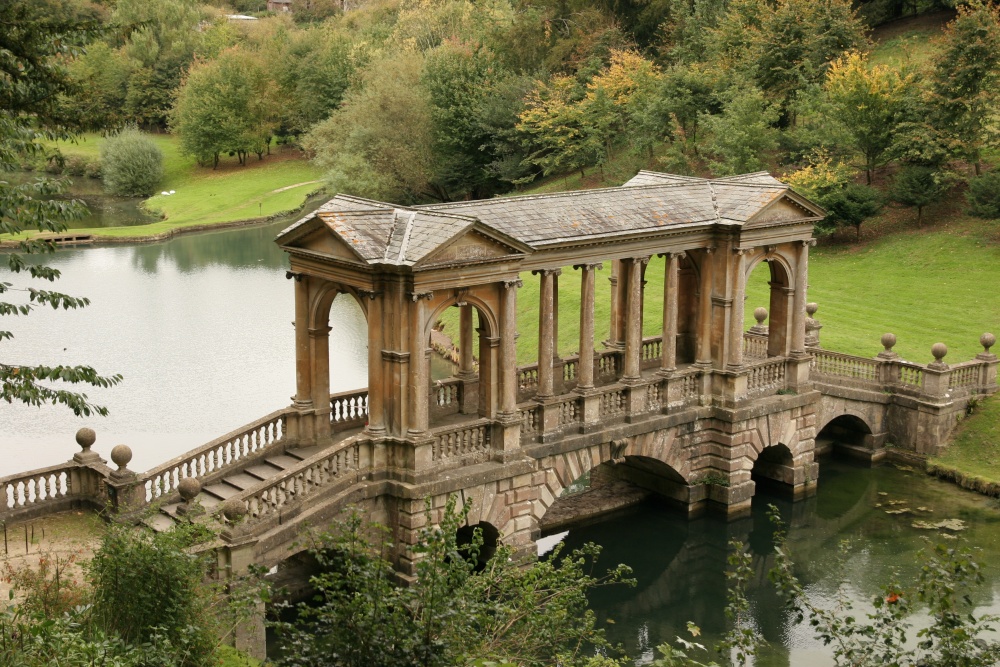
Prior Park, the Palladian Bridge - Image by PicturesOfEngland.com member Edward Lever (view gallery)
Capability Brown had a hand in establishing the stunning landscape of Prior Park. His services, together with the advice of poet Alexander Pope were sought by 18th-century Bath business man Ralph Allen to landscape the grounds of his beautiful Georgian mansion built in 1735.
Visitors to Prior Park can expect sweeping views of the glories of Bath, to walk over the famous Palladian Bridge, and to explore in exceptional peaceful surroundings a woodland full of wildlife habitats.
Every season brings its own riot of colour to these gardens. They are open all the year round, and allow for walks in tranquil surroundings at any time and offer wonderful spots to enjoy a summer picnic.
ID#8785

Snowshill Manor June 2008 - Image by PicturesOfEngland.com member Cees Zeelenberg (view gallery)
The romantic atmosphere of Snowshill Manor is made more vibrant by stories of ghostly happenings deep in the past. Given that a manor has existed here since the year 821 when the manor belonged to Winchcombe Abbey, it is easy to find some of the tales quite believable. Included in the list of illustrious owners of Snowshill is Katherine Parr, wife of Henry VIII and one time Queen of England, she received it as a gift from the King. Over the centuries the house was altered and added to but its main body dates from around early in the 16th-century.
In 1919 the house came up for sale, it was in a virtually ruinous state, hidden in a vast wilderness of overgrown plants and trees, in a garden that had lain untended for decades. However, underneath the mire, Wade sensed the old glowing beauty of Snowshill, it appealed to his artistic nature, and so he decided to buy it. His programme of restoration precluded modernity, there were no major alterations, nor additions, neither was there any electricity, Wade much preferred the intimacy of oil lamps and candles. The mellow Cotswold stone of which the manor was built was restored to its former glory, so too was the interior panelling and the elaborate fire-places where in winter Wade burned enormous log fires.
Charles Paget Wade set about filling his home with the same passion and zest he had used for restoring it. Over the years he amassed a collection of every imaginable artefact, these included - armour, toys, tapestries, paintings, clocks, dolls, furniture, marine instruments, musical instruments, costumes, and even bicycles. Within his collection there were many oddities, some said to be quite bizarre! Noted socialites of the day visited the manor, friends included Virginia Woolf, John Betjeman and Graham Green. His great friend J.B. Priestly called Snowshill ' that fantastic manor house' Priestly is said to have visited many times.
All through his life Wade continued to add to his collection, even when he married in 1946 and went to live for the most part in the West Indies, he continually purchased items to be brought back to Snowshill. In 1951 Wade gave Snowshill and its unique collection to the National Trust. By this time he had amassed in excess of 22,000 items and a costume collection numbering some 2,000 pieces. It was his wish that everyone should share in the pleasures derived from real craftsmanship, quality and beauty.
Wade even carried his Arts and Crafts Movement philosophy into the garden, where he set out a delightful theme of individual 'rooms' each in hues of Blue and Purple. Amongst the plantation there is a rich variety of painted garden ornaments, all in a pleasing shade of Blue.
Charles Paget Wade made his final visit to Snowshill whilst on a visit to England in July 1956. He was staying in Broadway when he was taken ill and died. He is buried with other members of his family in the churchyard at Snowshill.
Even today, younger generations of Snowshill talk affectionately of Charles Wade. It seems he was held in high esteem by the local population, it is therefore not surprising to find in Snowshill Manor wafts of the impish character of this unique charismatic man.
Snowshill Manor is in the care of the National Trust and is open to public view. It can be found amid undulating Cotswold scenery in the village of Snowshill, close to the charming town of Broadway.
ID#7511
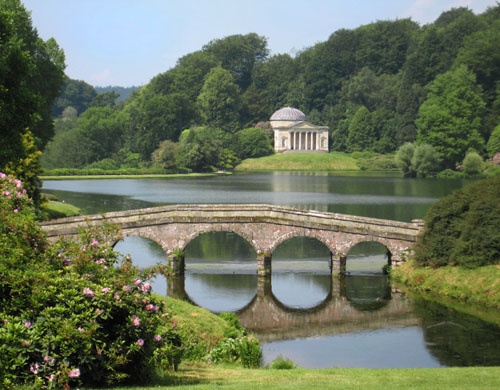
The lake, Stourhead, Wiltshire - Image by PicturesOfEngland.com member John Ware (view gallery)
Designed by Henry Hoare II, Stourhead is one of England's most picturesque landscape gardens with classic temples and palladian mansion.
ID#9284

Trerice, June 2009 - Image by PicturesOfEngland.com member Cees Zeelenberg (view gallery)
Elizabethan manor house with fine interiors and delightful garden
ID#10211

| Article Title | Author | Date |
| Stonehenge | David Coe | 23rd January 2024 |
| Derwent Dam: A Historic Icon in the Heart of Derbyshire | David Coe | 14th January 2024 |
| The Native Trees of England: A Botanical Tapestry | David Coe | 15th December 2023 |
| Stoke-on-Trent: The Potteries Hub | David Coe | 12th December 2023 |
| England's 'Heritage at Risk Register' 2023 | David Coe | 11th December 2023 |
| 10 of the prettiest villages in the Lake District, Cumbria | poe | 16th March 2023 |
| 10 Famous Landmarks in Dorset | poe | 1st March 2023 |
| List of popular Dorset market towns including market day | poe | 1st March 2023 |
| 10 Best Historic Attractions to visit in York, England | poe | 16th May 2022 |
| 9 Market Towns To Visit In The Cotswold | poe | 21st March 2022 |